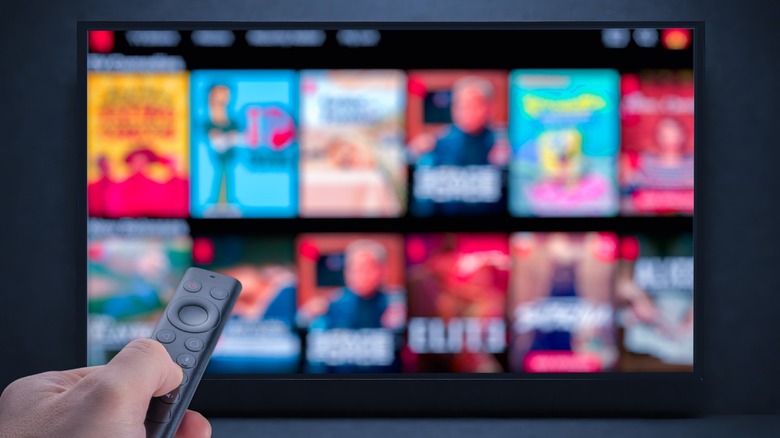How Long Can You Expect A Cheap TV To Last? Here's What Owners Say
TVs are a staple in many homes, offices, and buildings, meaning almost everyone owns one. In fact, chances are you probably have more than one in your home at any given time. Yet, for appliances that are so popular, not many people can place a finger on just how long TVs are supposed to last. Their lifespan seems to be less about assured expectation and more about user experience.
That difficulty gauging a television's life expectancy goes up a notch when it comes to a cheap one you can pick up for around $300 or less. If you shop for those televisions on the lower end of the price spectrum, you should expect around 45,000 hours of screen time. At 24 hours a day, that works out to just over five years. But in practice, the truth is that the number is optimistic for a given budget. The manufacturer assumes ideal conditions and doesn't account for potential pitfalls such as power supply failure or outdated smart software.
That said, review labs, online forums, product reviews, and real-user experiences — all indicate that many sets degrade over time, experiencing component failures earlier than ideal. So, even though the reasonable expectation of around four to six years checks out, it might not be trouble-free. Instead, some units may fail earlier, and others may last much longer, especially if used lightly.
Why cheap TVs age faster than you think
When it comes to televisions, you can't separate cost from quality. Buying a cheap TV means settling for lower-quality components and software, which, in itself, contributes to it feeling outdated sooner than you hoped. You aren't going to get an OLED display with the latest software tech for $300 or less. Your best bet is likely an LED or QLED display with decent built-in software. Most LED TVs are rated for 50,000 hours or around 6 years of use. But usage practices can extend that into the 10-year zone, which is much closer to the 100,000 hours expected from more expensive units.
Alternatively, you can save more of your bucks by picking a $150 TV, but expect nothing revolutionary. Products like those under Hisense's A4 series remain, according to owners, among the cheapest TVs worth buying in 2025. But its modesty means the trade-offs are hefty. Not only are you limited to smaller screen sizes, but you also get lower image quality. We're talking 720p and 1080p resolutions on 32 to 40-inch screens. Even then, longevity is not guaranteed as budget models still show signs of deterioration early, especially if used for long periods each day.
Modern TVs raise eyebrows about durability
There's no escaping the fact that advances in television technology seem to have harmed longevity in the process. Nowadays, TVs are outfitted with software that can quickly become outdated and render them obsolete. This is especially true of cheaper models, which are not equipped with the latest software and are prone to becoming outdated quickly. It does the opposite of turning an old dumb TV into a smart one.
Higher-quality older sets seem to have lasted much longer than many newer budget units. That's why, when it comes to budget TVs, real-world owner experiences offer more clarity than manufacturer specs. For instance, in a post on r/4kTV, u/bitAndy wrote: " I just got a new miniLED TV ... but my prior TV was a 2012 Panasonic plasma, and it still works fine." That said, many budget brands still get solid acclaim from their owners. Some TCL, Hisense, and Vizio owners have great things to say regarding their budget units. In a post on r/tcltvs, u/EmptyArachnid8477 states that their budget TCL has had no issues for four and a half years, even while running it 18 hours a day on Roku OS.
Owners generally say that cheap TVs are worth the price, being easy to set up and lasting about two to four years with light use, like streaming or casual viewing. But they also report durability issues, such as memory size, software aging, and slow response times. Overall, most owners of cheap sets judge them good enough at what they do rather than being long-term investments.
The role you play in extending your cheap TV's lifespan
Shifting focus to how you can prolong your TV's life, one life drainer that many owners overlook is poor ventilation. All appliances, including televisions, generate heat while in operation, and that heat needs an escape route. If you do not provide that escape route, internal components may begin to overheat, corrode, and ultimately fail. For this reason, the ventilation ports must remain open and not sealed off. Also, beware of the threat dust poses as another catalyst for the degradation of internal components. You can prevent this by cleaning the set regularly to keep dust from entering the unit and damaging it.
In the same regard, you can preserve or even extend your TV's lifespan by reducing the brightness when in use and powering it off when not in use. Lower brightness reduces the workload on TV components, improving overall durability. Once the screen starts to dim or doesn't even come on, then the lighting system may have deteriorated, causing screen burn. Additionally, you should keep an eye out for warranties and updates for your TV, as some brands offer to replace a damaged or outdated set for little to no cost. Most TV warranties last between one and two years, so if you wait too long, you will be stuck with it.



